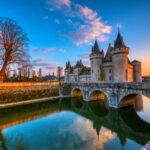Kefalonia Travel Guide
Introduction
Kefalonia Travel Guide – Although Kefalonia is the largest of the Ionian Islands, it’s also the least trodden. Once overlooked for Corfu and Zante, this jigsaw piece-shaped island is stepping out of the shadows of its siblings. And with jewel-toned waters, deserted beaches and pastel-painted villages, it’s not hard to see why. Kefalonia’s beauty is immortalised in Louis de Bernières’ novel-turned-film Captain Corelli’s Mandolin – yet it remains blissfully unspoiled by mass tourism. With bewitching turquoise and cerulean blue waters lapping up against white pebble beaches, and pine-scented limestone mountains slashed by lush, green fertile valleys, Kefalonia (Cephalonia) is the largest, and one of the most beautiful, of Greece‘s Ionian Islands. In the previous millennium, the island depended primarily on agriculture, but following the 2001 film Captain Corelli’s Mandolin, based on the book by Louis de Bernieres and starring Penelope Cruz and Nicholas Cage, tourism has become increasingly important. Almost all the island’s towns and villages were devastated by a terrible earthquake in 1953, so there is little architecture of historical interest, with one notable exception: somehow the village of Fiscardo survived the large-scale destruction. However, there are still plenty of beautiful places to visit on Kefalonia. The airport lies nine kilometers south of Argostoli, which is the island’s capital.
Why go?
Beaches, Nature and Picturesque Villages
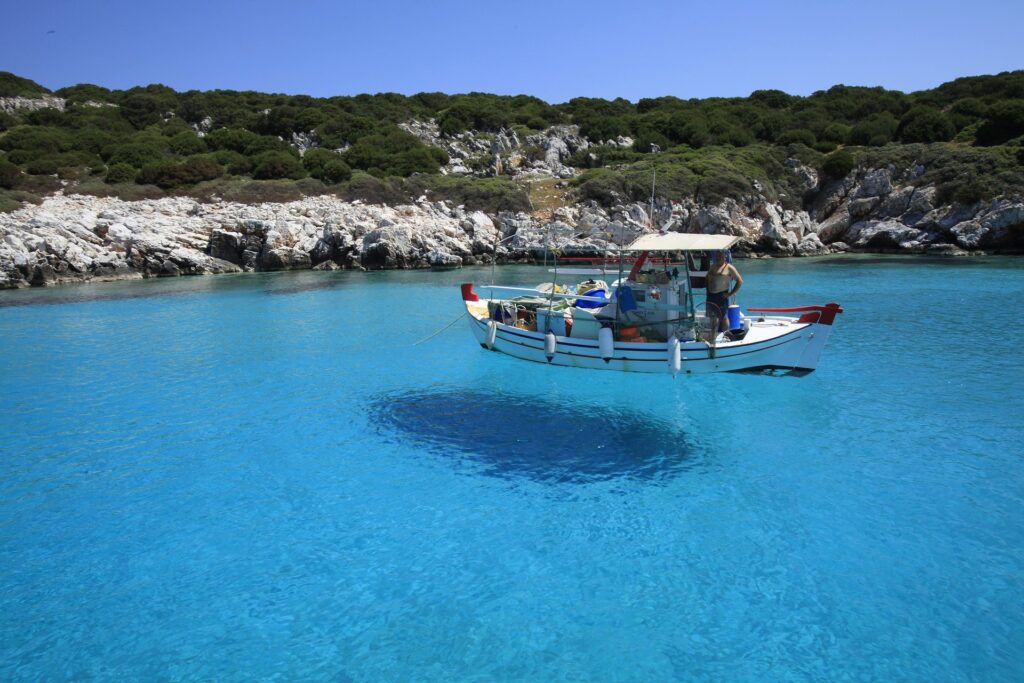
Worldwide famous for its scenic beaches (as Myrtos, Antisamos, Lourdas, Skala), dramatic landscapes and delicious food, the island attracts and bewitches thousands of visitors. Indigo bays, enchanting villages (Fiscardo, Argostoli, Sami, Assos), white dazzling sand, exciting activities, mysterious caves, and lively atmosphere create an exotic holiday paradise in the middle of the Ionian sea. The main reason why people keep on coming to Kefalonia is, without any doubt, its wonderful beaches. Sure, some beaches always look good on pictures, but Kefalonia’s most photographed beaches look even better in real life! From Myrtos, an idyllic sandy beach backed with towering cliffs, to Petani, Xi, Skala and Makris Gialos, every Kefalonia beach will steal your breath! As for Kefalonia villages, they ooze charm in abundance! Apart from the capital of the island, Argostoli, don’t miss to visit the tiny villages of Fiskardo and Assos, during your Kefalonia holidays. Take in the magical scenery, stroll around their little harbors and, of course, sit at a tavern to taste the yummy local delicacies… You’ll forget- even just for a while- the sounds of the city! The exploration continues in the mysterious lake cave of Melissani. Hop on one of the little boats that make tours around the cave and immerse yourself in the magical atmosphere of this natural wonder. Just imagine turquoise waters, stalactites and trees washed out by the light that sneaks into the cave from a hole above it. It’s an experience that is out of this world!
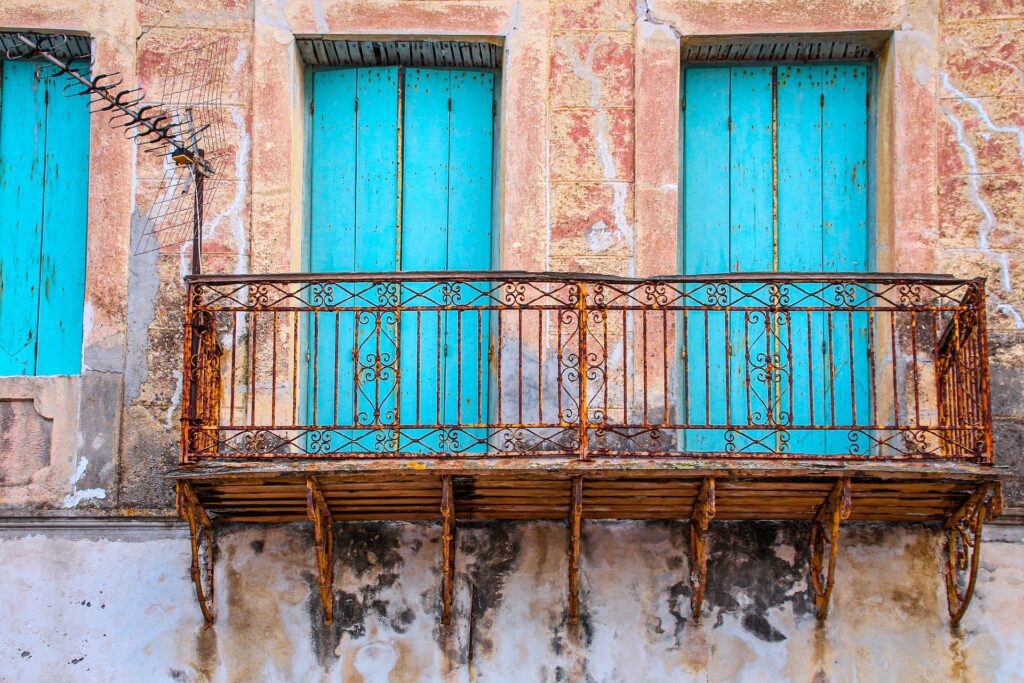
Mountains
Kefalonia is a place where mountains plunge to meet the sea. If you’re a sun-seeker, you’ll be rewarded with some of the finest beaches in Greece. While the southern sandy stretches may be well-trodden, the further north you go, the fewer people you’ll come across. For those who can’t sit still for long, hiking the mountainous landscape is one of the more adventurous things to do in Kefalonia. Mount Ainos, nudging 5255ft, is the highest peak in the Ionian Islands – expect views for days.
Food
Plump lemons, hand-pressed olive oil, tender lamb – Kefalonia’s cuisine draws upon the natural larder of the island. That’s not to say it’s all farm-to-fork fare: seared halloumi tops the list for cheese-lovers, while sweet treats don’t come much sweeter than loukoumades – deep-fried doughnuts soaked in honey and sesame. For the best restaurants in Kefalonia, pick a traditional tavern like Waterway, poised on the cliff edge beneath Spartià, or the harbor front Tassia in Fiskardo. Local wines Robola and Muscat are the tipples of choice; we recommend Gentilini and Haritatos Estate for vineyard tours and wine tastings.
History
Kefalonia has a complex – and at times bloody – history. Islanders were dealt a double blow in the mid-20th-century, their lives upended first by the Second World War and then by an earthquake – as chronicled in Louis de Bernières’ novel. Kefalonia was overrun by Italians and Germans during the war, and the site of a shameful atrocity: Nazi forces massacred five thousand Italian soldiers during the “handover” of 1943 – a monument on a wooded peninsula behind Argostoli commemorates their memory. Only 10 years later, the 1953 earthquake destroyed towns and villages across the island; crumbling ruins are haunting reminders of this natural disaster.
Villages and Towns
Fiskardo
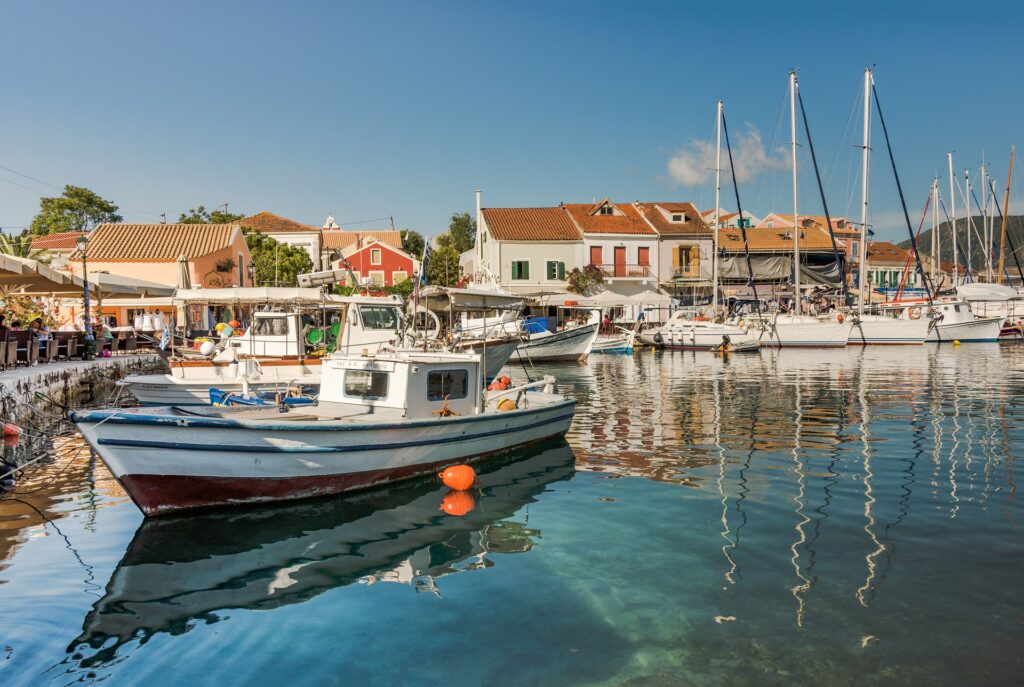
Unquestionably Kefalonia’s prettiest village, Fiscardo lies on the northeastern tip of the island and is the only settlement to have retained its 18th-century Venetian-style architecture from before the earthquake. Backed by a dense cypress glade and built around a sheltered bay, it is popular with sailing crews who moor up their yachts here on summer nights. Most of the houses around the harbor now host upmarket seafood eateries, cafés, and holiday homes. This picturesque fishing village is recognized as a traditional preservable settlement as it is one of the few villages that remained untouched from the major earthquake of 1953. Today it is known for its cosmopolitan and warm atmosphere. There is a massive amount of tourism in this small village but it manages to hold its beauty against all odds. The main coastal road hosts plenty of shops, taverns and bars and it throbs with activity during the summer. The traditional and Venetian buildings and houses with pretty colors embrace the natural bay offering the village a unique charm while reflecting the rich heritage of Kefalonia. Mostly for its amazing beauty, Fiscardo has become an attractive destination for thousands of visitors every year. Nearby the village one can find many beautiful pebbled beaches and stunning coves with calm and crystalline waters as well as ruins of a Palaeolithic settlement and plenty of Byzantine churches, and many other picturesque and interesting sites. The Natural and Environmental Museum lies above the waterfront and it is worth a visit.
Ássos
Ássos is a peaceful little village on the island’s northwest coast, 10-kilometers from the popular village of Fiskardo. It is built on a causeway linking a hilly peninsula to the mainland. To reach it, you drive down a series of hairpin bends to where the village nestles in a quaint harbor, rimmed by seafood taverns. The peninsula is capped by the ruins of a 16th-century Venetian castle, which you can walk up to for a closer look (allow about 40 minutes), and there are a couple of pebble beaches close to the village, where you can swim. Today, it counts about one hundred inhabitants and is one of the most charming spots of the island. Dominated by the ruins of a 16th century Venetian castle, the village of Assos is built on a small peninsula reflecting a beautiful and warm atmosphere. The traditional architecture, the peaceful landscape and the pebbled beaches compose the natural beauty of Assos. A stroll around the narrow alleys reveals colorful houses with pink and white blooms, lovely paths and old churches. Little taverns perched on the quayside overlooking the bay attract most of the visitors. The visit to the castle requires a long walk amidst the olive tree forests until you reach an archway.
Argostóli

On a peninsula on Kefalonia’s southwest coast is the capital city of Argostóli. Although its history predates the 1950s, the old town was almost completely obliterated in an earthquake in 1953 and was rebuilt in modern style, following the original town plan. As a result, today it is a picturesque place, with a palm-lined seafront promenade, where local fishing boats moor up. While in town, check out the small archaeological museum, which displays finds from the Mycenaean, Hellenistic, and Roman periods.
Sámi

Located on the east coast, some 24 kilometers east from Argostóli, Sámi is the island’s main port, served by regular ferries to and from Patras on the Greek mainland. The ancient town of Sami lay to the south of the modern town, on the slopes of the double-topped hill — the remains of the acropolis can still be seen, and from here, you have fine views down onto the bay. Sami is a perfect destination for your summer holidays in Greece. The delightful waterfront, the wide paved streets and the Venetian buildings offer the village a unique charm and reflect the rich heritage of the island. The main coastal road consists of modern amenities, shops and lovely cafes overlooking the busy port. A number of restaurants are found nearby as well as pretty accommodation for all tastes and budgets.Sami is surrounded by a dream landscape of verdurous imposing hills and stunning coves. Tourists arrive here with their private yachts to enjoy a unique diving and swimming experience at the green waters of Kefalonia. The village is home to some of the most interesting monasteries and sights in Kefalonia like the monastery of Agrilia, as well as beautiful caves (like Karavomylos and Dragati), some stunning underground lakes like the one at Melissani and Antisamos beach. During summer, the municipality of Sami organises some interesting cultural events and local festivities, concerts and theatrical performances
Agia Efimia
Once just a fishing village, the harbour here is the centre of attraction. Around it there are a number of fish taverns and small hotels. Agia Efimia serves as a starting point for excursions around the island. Agia Efimia is a coastal picturesque village 31.5 km northeast of Argostoli, the capital of Kefalonia. It lies around the natural bay and it is home to a small and lovely port where fishing and excursion boats moor. Today, Agia Efimia counts on 450 inhabitants most of whom are engaged in agriculture, farming and fishing. Over the years it has become one of the island’s major attractions and every summer the streets of the village throb with activity. Marvelous taverns and restaurants line the waterfront overlooking the wonderful bay. The village offers a nice choice of accommodation for all tastes and budgets. The beautiful beaches, the paved streets and the beautiful architecture compose the unique setting of the village. Close to Agia Efimia, at a high altitude are found remains of old fortresses and venetian buildings. One shall visit the lovely churches and the nearby traditional villages. Those who own a boat should definitely explore its pristine isolated beaches and stunning coves.
Skala
The beautiful resort of Skala lies 36 km southeast of Argostoli, the capital of Kefalonia and 12 km from Poros village. It counts on 420 inhabitants most of whom are involved in fishing and agriculture. Skala was built after the major earthquake of 1953 that destroyed the ancient village of Skala. The ruins of Old Skala still survive today. Being the largest resort of the southern part of Kefalonia, Skala welcomes hordes of tourists and Greek travelers every summer who wish to spend pleasant and relaxing holidays. Skala stands out for its natural beauty and unspoiled green landscape as well as crystalline waters and stunning coves. The long beach is located right above the settlement surrounded by lovely pine tree forests and rock formations. It is quite developed with tourist facilities and a water sports center. It is a famous destination for the summer offering plenty of modern amenities mostly gathered on the main street of the village. he village reveals interesting ruins of a Roman Villa dating back from the 2nd century BC with magnificent mosaic floors. Nearby is an old village with notable architecture and watermills. The settlement offers an excellent view to the Ionian sea.
Kourkoumelata
Kourkoumata is one of the most beautiful, picturesque and impressive villages of Kefalonia. Without being extremely famous among tourists and Greek travelers, Kourkoumelata distinguishes for its remarkable views to the endless sea and its unique layout. It is located 9 km from Argostoli, the capital of Kefalonia. This idyllic village was totally destroyed by the major earthquake of 1953 but it was completely rebuilt with the financial support of the shipowner Giorgos Vergotis who managed to reconstruct the entire village according to the neoclassical architectural tendencies of those times. Kourkoumelata is considered the most elegant settlement in Kefalonia with well-maintained beautiful buildings known for their rich and diverse architecture. However, apart from these magnificent structures, the colorful and well-cared gardens are the main attraction of Kourkoumelata that is really worth admiring. These wonderful compositions adorn the entire village and create a warm and welcoming atmosphere.
Poros
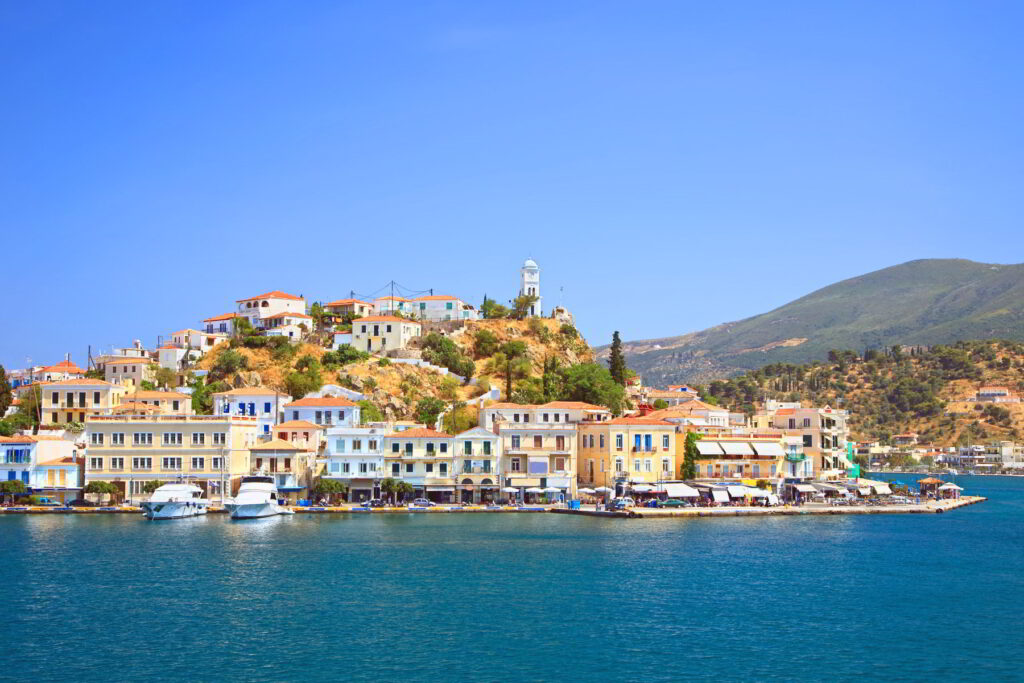
Poros is an attractive coastal settlement located 40 km south-west of Argostoli, the capital of Kefalonia. Today it has a population of about 1100 inhabitants. Built around a marvelous landscape of lush green forests, Poros is also home to a picturesque port that serves itineraries to Patra and Killini, in Peloponnese. The combination of dense and verdant vegetation along with the crystal blue sea makes this village one of the most perfect summer destinations. Apart from its beautiful landscape and traditional layout, Poros has become a famous tourist resort in Kefalonia welcoming a great number of tourists and Greek travelers during the summer. Plenty of restaurants and traditional taverns line the waterfront and picturesque cafes. The village has important sightseeing that one should definitely see. Among them is the impressive Drakena Cave and the superb gorge of Vohyna. Also, the monastery of Atros is worth visiting.
Lixouri
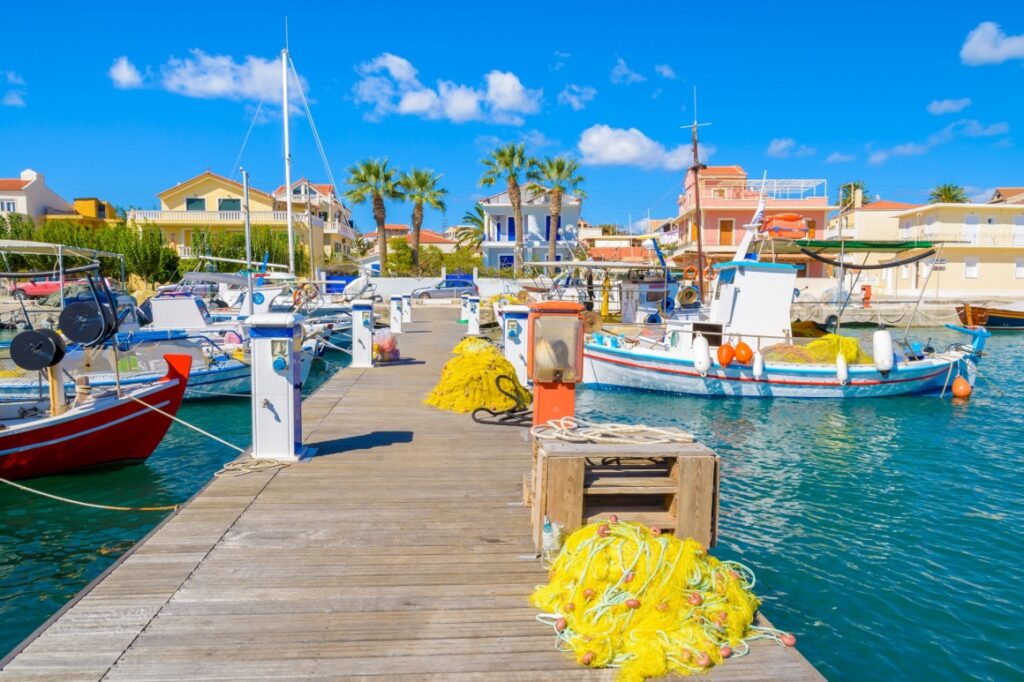
Lixouri is the second largest village of Kefalonia, located 35 km west of Argostoli. Today, it counts on 3000 inhabitants most of whom are engaged in agriculture and tourism. The town lies around the blue bay of Argostoli overlooking the capital. Regular ferries connect the two destinations. The beautiful town of Lixouri was built on the site where the ancient city of Pali used to be, one of the four principal cities of Kefalonia during Antiquity. Due to the major earthquake of 1953 the city was destroyed and only a couple of mansions survived and can still be seen today. Similar to its neighbor town Argostoli, Lixouri gathers a great number of tourists from the beginning of the summer season. Plenty of restaurants and bars line the busy waterfront and modern bars filled with young crowds. The main square Plateia Petritsi is at the centre of attention surrounded by many old-fashioned cafes. The village organizes many local festivals throughout the year. It is well-known for its rich cultural tradition and hosts one of the oldest philharmonic schools in Greece. Most of the locals in Lixouri are famous for their musical capacities. A stroll around the village reveals old churches with nice frescoes, an archeological museum, neoclassical buildings and the famous Monastery of Kipoureon which is an ideal place for isolation. For swimming you can visit the beautiful beach of Lepeda, Xi and Mega Lakos located in close distance from the village.
Svoronata
Svoronata is a small beautiful village on the southern side of Kefalonia. Only 9 km from Argostoli, the capital of the island, Svoronata is also the closest village to the airport of Kefalonia. A village with interesting samples of local architecture, Svoronata is found close to lovely beaches, including Ai-Helis, Avithos, Ammes, Platis Gialos and Makris Gialos. All these beaches have crystal water and soft sand. The surrounding region is lush green and well-developed in tourism, with hotels, studios and seaside taverns.
Peratata
Peratata is a small and picturesque village located 8 km southeast of Argostoli, the capital of Kefalonia. It is built on the slopes of a hillside of Mountain Ainos surrounded by a verdant landscape. At the top of the hill stands the 16th century castle of Saint George dominating the village. The population of the village is about 500 inhabitants. Those who visit Peratata will definitely enjoy the peaceful atmosphere and the traditional way of life. The village hosts many traditional taverns serving delicious food. A stroll along the settlement reveals the old architecture with pretty stone houses. Paths lead to various monuments that reflect the rich history and tradition of the area. Peratata is home to several sightseeings such as the Monastery of Agios Andreas and its Byzantine Museum, the Venetian Castle and the Mycenaean tombs. Peratata guarantees a pleasant stay with various accommodation and some modern amenities for the tourists
Best Attractions in Kefalonia
Melissani Cave & Lake
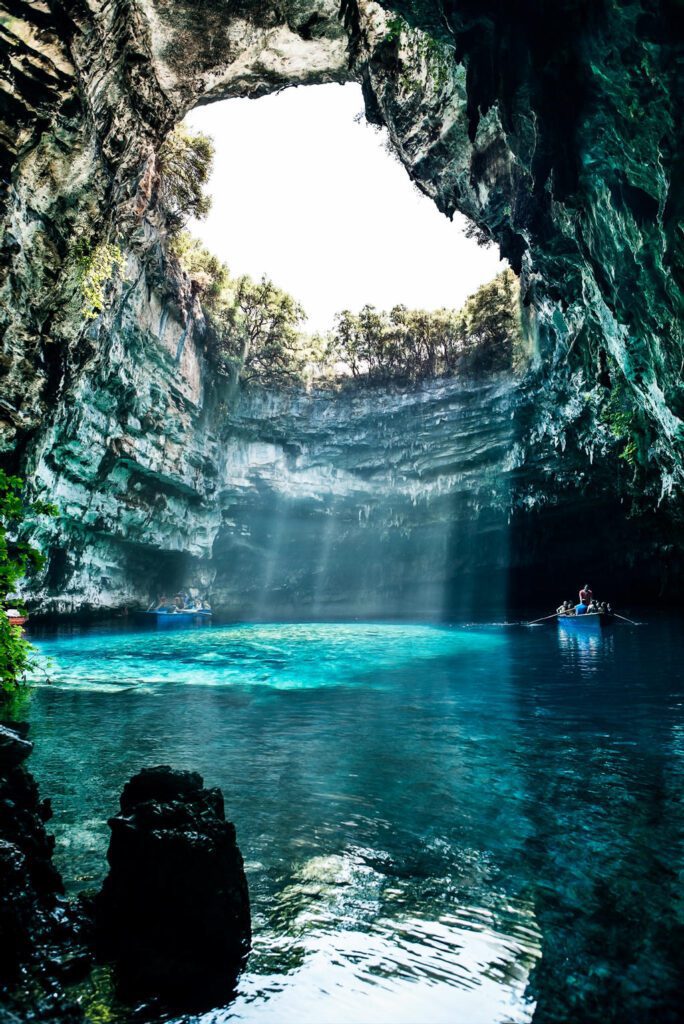
Northwest of Sámi, Melissáni Cave is home to an underground lake. To visit it, you walk down a flight of steps to a landing stage, then climb aboard a small rowing boat with an oarsman for a 15-minute trip around the lake. The roof of the cave fell in years ago, and sunlight enters through the hole in the roof, creating amazing shades of blue-colored light on the cave walls. The best visual effects occur around noon, when the sun is overhead. Archaeological finds suggest that the cave may once have been used as an ancient place of worship. Surprisingly, there is a lake inside the cave that has trees and forests surrounding it. The cave itself is B-shaped with two chambers or halls separated with land or an island in the center. The roof of one of the halls caved in centuries ago letting sunlight filter in. The depth of the lake is 20 to 30 meters. When the sun is right overhead at noon, the sunlight hitting the turquoise-blue waters create a magical illusion and the whole Cave of Melissani suddenly feels lit with blue light. Slanting rays in the morning and evening have the magical quality of their own. One gets an ethereal feeling of boats hovering in the light! Myth has it that the cave was named after the nymph Melissanthi who committed suicide because her love for God Pan was not reciprocated.
Drongarati Cave
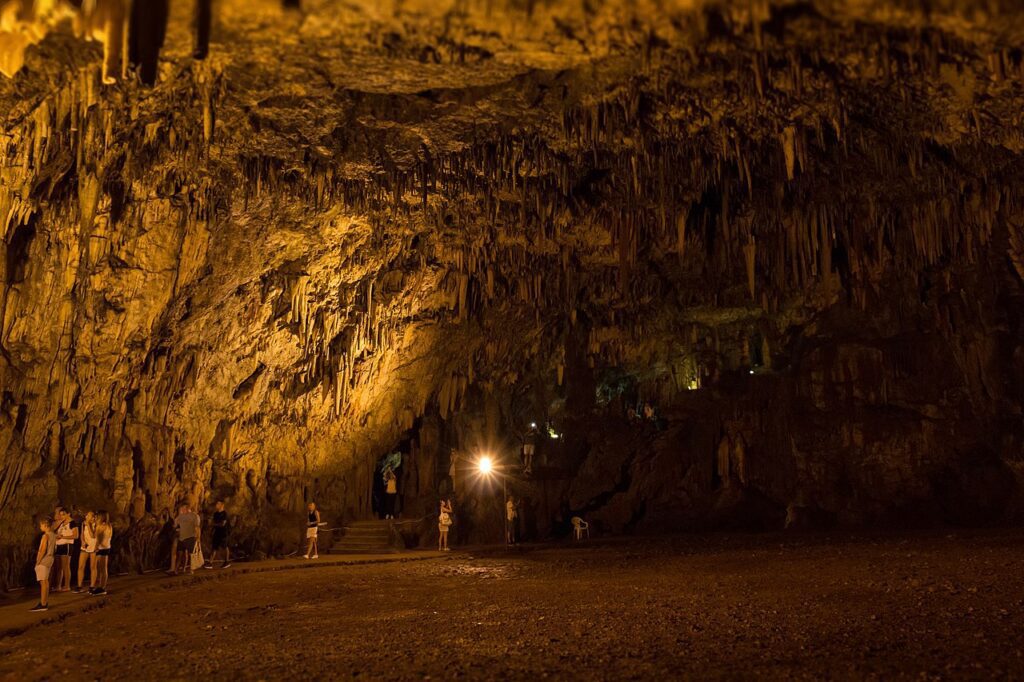
Southwest of Sámi, near the village of Khaliotata, the Drongaráti Cave is huge — 95 meters long and 45 meters broad at its widest point. To enter it, you walk down a long flight of steps to arrive in an eerily beautiful cavern, well lit and filled with magnificent stalactites and stalagmites. The second chamber has outstanding natural acoustics and occasionally hosts concerts — American-Greek soprano Maria Callas is said to have sung here.
Ainos National Park
In the south of the island, the summit of Mount Ainos is the highest point in Kefalonia and rises 1,628 meters in elevation inside a national park. The upper altitudes are covered in dense pine forests of the species Abies cephalonica (Kefallonian fir), which is endemic to Greece and has remained exceptionally pure here due to the isolation of the island. The national park is ideal for hiking and mountain biking, and bird-watchers might spot woodpeckers, eagles, vultures, and hawks
Boat Excursions
One of the favorite things to do in Kefalonia is to book a boat tour around the island for a half or full day. From deserted beaches to hidden coves, the island is filled with beautiful spots that will take your breath away. There are numerous companies offering tour options, from glass-bottom boat excursions and full-day beach and village tours to snorkeling or scuba diving adventures. For diving, popular spots include Temple Cave; the Blue Lagoon; and the WWII shipwreck dive to see the Ardenia, which hailed from Italy.
Go beach-hopping
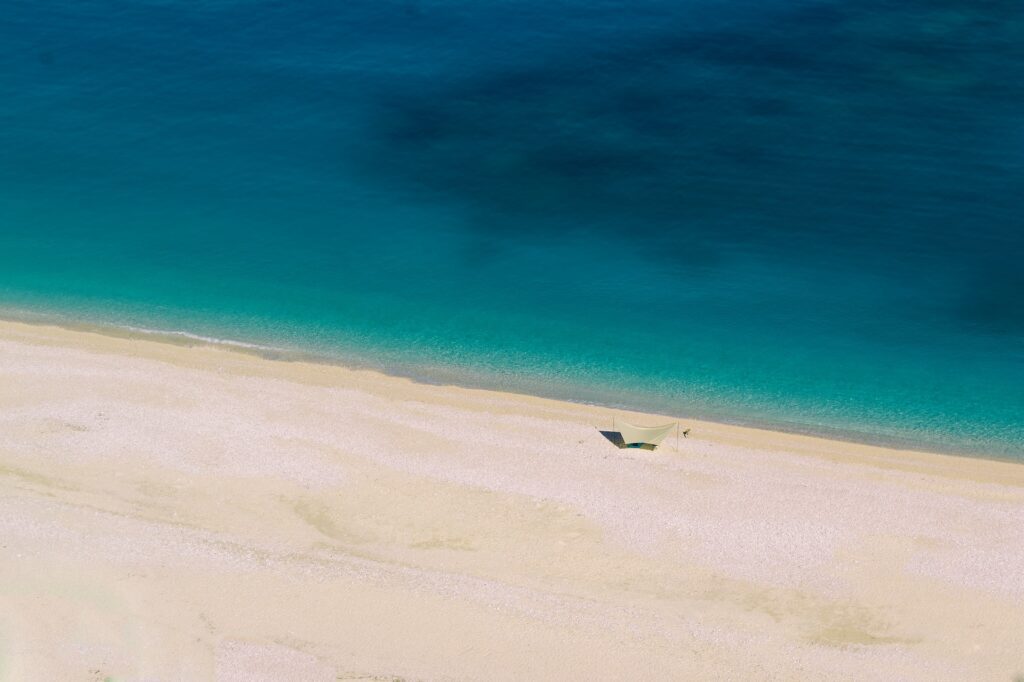
The poster child for idyllic Greek beaches, Myrtos is all icing-sugar sand and crystalline waters. However, it’s also widely regarded as one of the best beaches in Kefalonia, so you can expect hordes of tourists. Instead, head north to find a few quieter stretches. Near Fiskardo, tiny Dafnoudi or Emblisi are tranquil hideaways, where you can snorkel in the electric-blue sea – the most enchanting of things to do in Kefalonia. One of the most photographed beaches in all of Greece is on Kefalonia. On the island’s northwest coast, near Assos, Myrtos is beautiful. The two-kilometer-long beach is backed by dramatic limestone cliffs and fringes an amazing turquoise-blue sea. It’s made of smooth white pebbles that, from afar, resemble sand. The view from the road above is stunning. The beach itself is a little wild — there’s no natural shade from the afternoon sun, and the seabed shelves suddenly into deep water with strong currents, so you need to be a confident swimmer. In a deep, curving bay on the east coast, three kilometers from the port town of Sámi, Antisamos is one of the most popular beaches on Kefalonia. Like Myrtos Beach, it is made up of white pebbles and backed by hills planted with pine woods. It has limited facilities with just a taverna plus sun-loungers and umbrellas for hire. The sea is warm and clear and ideal for snorkeling, and the beach scenes in Captain Corelli’s Mandolin were filmed here.
Agios Gerasimos Monastery

Saint Gerasimos, born in 1503 in Trikala Thessaly, is the protector saint of Kefalonia. Saint Gerasimos was ordained a monk at Mount Athos, then went to Jerusalem where he lived for 12 years, passed to Crete and Zakynthos to finally arrives in Kefalonia where he died on August 15th, 1579. He was declared a saint in 1622. The monastery is considered one of the most sacred pilgrimages in Kefalonia hosting a great number of visitors. A small church to Agios Gerasimos has been built above the tomb and the cave of the saint. The Saint also had planted a plane tree which is still preserved at the monastery. On his feast day, August 16th, there is a grand litany for the commemoration of the saint’s death in which his sarcophagus is paraded and laid under the plane tree. Agios Gerasimos was known for his miraculous abilities to cure people with mental illnesses. His miracles which became widely known across the country led to the removal of his relics that were found totally incorrupt. Today, his relics are saved in double glass reliquary placed above the saint’s tomb.
Municipal Theatre
The Municipal Theatre Kefalos of Kefalonia is located in Argostoli, on Georgiou Vergoti street, just opposite the Archaeological Museum. This beautiful theatre is one of the largest and oldest in Greece. It looks impressive with its neoclassical architecture and the big yard in front of it. This theatre was inaugurated in 1858 when Kefalonia and all the Ionian islands were under British rule. In fact, the first performance to take place there was the famous opera La Traviata by Giuseppe Verdi. Ever since, it became an important cultural center for the presentation of operas and operettas in Greece, until it was bombed by the Germans in 1943, during the Second World War. The theatre was severely damaged at that time and only recently was it restored. Today, the Municipal Theatre of Kefalonia hosts many theatre performances, dancing shows, scientific conferences, and artistic exhibitions. It has a large amphitheatre of 450 seats and other smaller rooms.
The lighthouse of Saint Theodoroi in Argostoli

The lighthouse of Saint Theodoroi lies on a man-made peninsula close to Argostoli village, the capital of the island. It is a circular structure with 20 columns and its tower is 8 m tall. The building has a rather simple and Doric architectural style, while its focal plane is 11 m. It was originally built in 1828 by the British administrator Charles Napier, who ruled the island that time. Although the British military rule was quite severe, they built important works that contributed to the prosperity of Kefalonia. In 1863, after the integration of the island to the Greek State, this lighthouse was included in the lighthouse network of Greece. The earthquake of 1953 was pretty devastating for Kefalonia and the other Ionian islands and also destroyed the lighthouse. It was rebuilt in 1960 by the local architect Takis Pavlatos according to its original architectural design. The lighthouse of Saint Theodoroi works till today and gives a romantic view at night. It is found 3 km from Argostoli, close to Katavothres, or you will see it if you take the boat to Lixouri village.
Related Reading:
What to Photograph in Greece?, Greece Family Tours,









